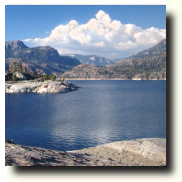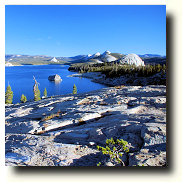McKinley Grove Near Dinkey Creek |
McKinley Grove
Located on McKinley Grove Road on the way to Wishon Lake. Travel 11.7 miles east to the Intersection of the Dinkey Creek Road and the McKinley Grove Road. Turn right and travel 5.7 miles north on the McKinley Grove. This is where you'll find centuries old giant Sequoia trees in a lush forest with wildlife, picnic area and restrooms. This is a wonderful place to go for a leisurely hike and enjoy the scenery.
 If you look closely you may see deer, chipmunks, squirrels and beautiful birds. The lush under growth has a variety of wild flowers and other interesting seasonal plants. There is plenty of shade. If you look closely you may see deer, chipmunks, squirrels and beautiful birds. The lush under growth has a variety of wild flowers and other interesting seasonal plants. There is plenty of shade.This makes a wonderful place for a quiet stop for your journey to Wishon Lake. There is an excellent resort near Wishon called Wishon Village RV Resort. It has RV and tent camping facilities, a marina and general store. McKinley Grove nature trail A short nature trail loops through the 80-acre McKinley Grove of Giant Sequoias, near Dinkey Creek. The McKinley Grove of Giant Sequoias straddles the McKinley Groev Road south of Dinkey Creek. Giant sequoias are the world's largest single trees by volume. Giant sequoias grow to an average height of 50–85 m (164–279 ft) and 6–8 m (20–26 ft) in diameter. Record trees have been measured to be 94.8 m (311 ft) in height and over 17 m (56 ft) in diameter.[3] The oldest known giant sequoia based on ring count is 3,500 years old. Sequoia bark is fibrous, furrowed, and may be 90 cm (3.0 ft) thick at the base of the columnar trunk. It provides significant fire protection for the trees.  The leaves are evergreen, awl-shaped, 3–6 millimetres (0.12–0.24 in) long, and arranged spirally on the shoots. The seed cones are 4–7 centimetres (1.6–2.8 in) long and mature in 18–20 months, though they typically remain green and closed for up to 20 years; each cone has 30–50 spirally arranged scales, with several seeds on each scale, giving an average of 230 seeds per cone. The leaves are evergreen, awl-shaped, 3–6 millimetres (0.12–0.24 in) long, and arranged spirally on the shoots. The seed cones are 4–7 centimetres (1.6–2.8 in) long and mature in 18–20 months, though they typically remain green and closed for up to 20 years; each cone has 30–50 spirally arranged scales, with several seeds on each scale, giving an average of 230 seeds per cone.The seed is dark brown, 4–5 millimetres (0.16–0.20 in) long and 1 millimetre (0.039 in) broad, with a 1-millimetre (0.039 in) wide, yellow-brown wing along each side. Some seeds are shed when the cone scales shrink during hot weather in late summer, but most are liberated when the cone dries from fire heat or is damaged by insects. |
